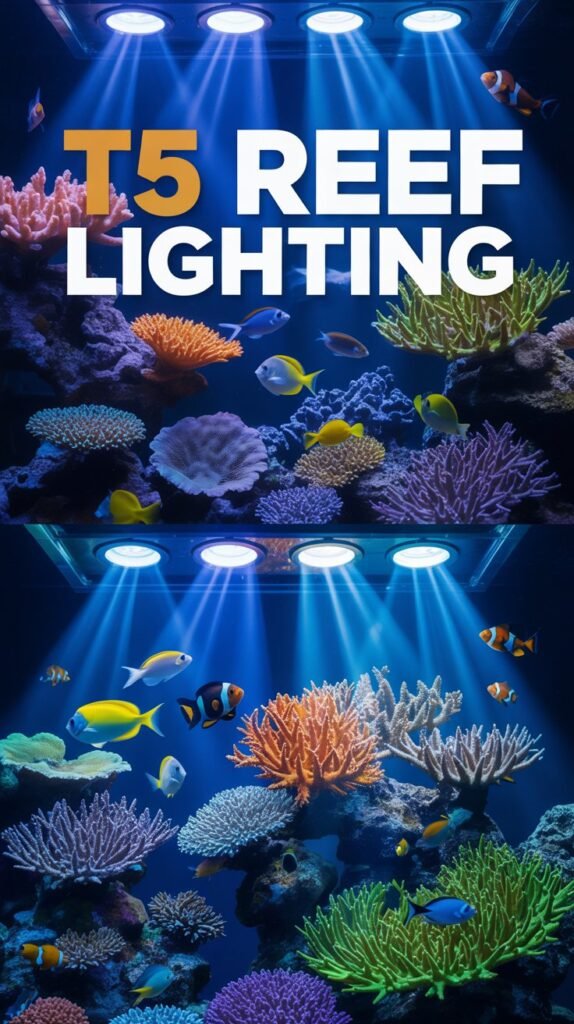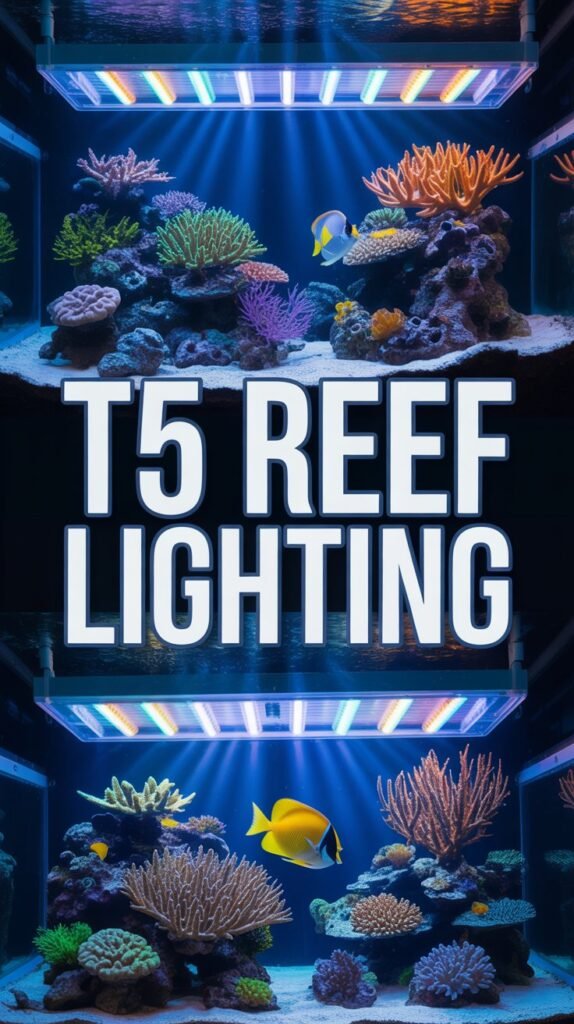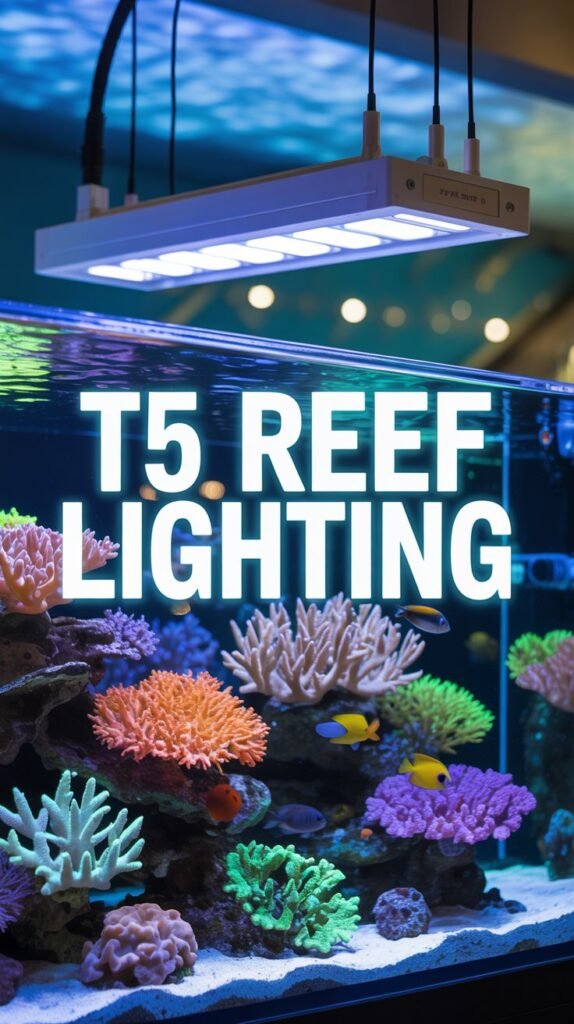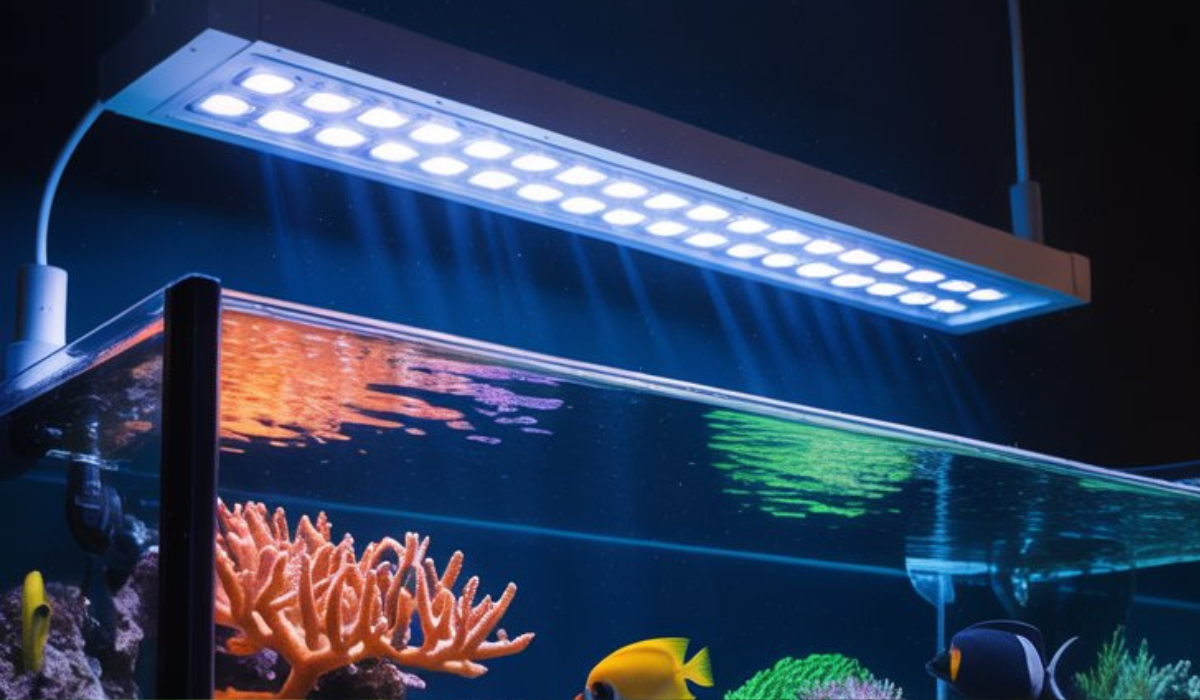When it comes to maintaining a thriving reef aquarium, lighting plays a crucial role. The right lighting setup not only enhances the beauty of your corals and fish but also ensures optimal coral growth and health. Among the many options available, T5 reef lighting stands out as one of the most reliable and effective choices for both beginners and advanced aquarists.
In this comprehensive guide, we’ll explore everything you need to know about T5 reef lighting — from how it works to how to choose, install, and maintain it for the best reef tank results.
What Is T5 Reef Lighting?
T5 reef lighting refers to T5 fluorescent bulbs used in reef aquariums. The “T5” stands for tubular bulb type with a 5/8-inch diameter. These high-output (HO) fluorescent tubes emit powerful, evenly distributed light suitable for coral growth.
Unlike traditional incandescent or compact fluorescent lights, T5 lights produce a consistent, bright, and controllable spectrum. They are often installed in multi-bulb fixtures, allowing aquarists to blend different color temperatures for the perfect reef look.
Why T5 Lighting Is Popular in Reef Aquariums

There are several reasons why T5 reef lighting remains a top choice among reef keepers, even with the rise of LED technology:
1. Excellent Light Spread
T5 bulbs distribute light evenly across the tank, minimizing shadows and ensuring every coral receives adequate illumination. This uniformity promotes balanced coral growth from top to bottom.
2. Proven Coral Growth Performance
Reef hobbyists have trusted T5 lighting for decades because it effectively supports coral photosynthesis. Both SPS (Small Polyp Stony) and LPS (Large Polyp Stony) corals thrive under T5s.
3. Customizable Spectrum
T5 fixtures typically hold multiple bulbs, each with different color spectrums — such as actinic blue, coral plus, or aquablue special. You can easily combine bulbs to achieve your desired look and coral coloration.
4. Affordable and Reliable
Compared to high-end LED systems, T5 setups are more affordable and provide consistent output without complex programming. They are also known for their reliability and long lifespan when maintained properly.
5. Low Heat Output
While T5s produce some heat, it’s significantly less than metal halide lights. This helps maintain stable water temperatures, reducing the need for additional cooling equipment.
How T5 Reef Lighting Works
T5 lights operate by passing an electrical current through a gas-filled tube coated with phosphor. The gas emits ultraviolet (UV) radiation, which excites the phosphor coating and produces visible light.
For reef aquariums, T5 High Output (HO) bulbs are used because they deliver higher intensity and are optimized for coral growth. These bulbs are powered by electronic ballasts that ensure efficient energy use and consistent brightness.
Each bulb emits a specific light spectrum, such as:
- Actinic Blue (420–460nm) – Enhances coral fluorescence and supports zooxanthellae photosynthesis.
- Aquablue Special (10,000–12,000K) – Provides bright white light for natural appearance.
- Purple Plus – Boosts reds and pinks in corals.
- Coral Plus – Combines multiple wavelengths for balanced growth and vivid colors.
Benefits of T5 Reef Lighting
T5 reef lights offer a range of advantages that make them ideal for various reef setups.
1. Balanced Lighting Spectrum
T5s offer a natural daylight spectrum, ensuring corals receive the full range of light wavelengths they need for photosynthesis. This helps maintain vibrant coloration and steady growth.
2. No Harsh Light Spots
Unlike LEDs that can create intense hotspots, T5 lighting covers the entire tank evenly, which prevents coral bleaching or uneven light exposure.
3. Proven Longevity
With proper care, T5 bulbs typically last between 9 to 12 months before their output declines. The fixtures themselves can last several years with minimal maintenance.
4. Compatibility with Hybrid Systems
Many reef keepers now use T5 + LED hybrid systems to enjoy the best of both worlds — the even spread of T5s and the shimmer of LEDs.
5. Simple Maintenance
T5 fixtures require very little maintenance — just regular bulb replacements and occasional cleaning of reflectors and fans.
Choosing the Right T5 Fixture for Your Reef Tank

Selecting the right T5 reef lighting system depends on your tank’s size, coral types, and desired aesthetic. Here are the key factors to consider:
1. Tank Size
Larger tanks require longer fixtures and more bulbs. For example:
- 20–40 gallons: 2–4 bulb fixtures
- 55–90 gallons: 4–6 bulb fixtures
- 120+ gallons: 6–8 bulb fixtures
2. Type of Corals
- Soft corals and LPS: Moderate lighting — 4-bulb T5 fixture is sufficient.
- SPS corals and clams: High lighting — go for a 6- or 8-bulb fixture with high PAR output.
3. Reflector Quality
High-quality individual reflectors maximize light efficiency, directing more illumination into the tank instead of wasting it sideways.
4. Ballast Efficiency
Look for electronic ballasts designed for T5 HO bulbs, as they ensure consistent brightness and reduce flickering.
5. Fixture Cooling
Efficient cooling fans prolong bulb life and maintain optimal performance.
Best T5 Reef Lighting Brands (2025)
Several reputable brands offer top-quality T5 fixtures and bulbs for reef aquariums:
- ATI Aquaristik – Renowned for its SunPower and Powermodule fixtures that deliver outstanding PAR and color blending.
- Giesemann – Offers premium designs with exceptional build quality and advanced reflectors.
- AquaticLife – Known for affordable yet efficient hybrid systems combining T5 and LED lights.
- CoralVue – Produces reliable fixtures and retrofit kits ideal for custom setups.
Each brand provides a variety of bulb options so you can tailor your lighting spectrum perfectly to your reef tank’s needs.
Installing T5 Reef Lighting: Step-by-Step Guide
Setting up your T5 reef lighting is simple, but attention to detail ensures optimal performance:
- Mount the Fixture Properly
Place the fixture 6–10 inches above the water surface for even light spread and to prevent water splashes. - Use Reflectors
Individual reflectors improve efficiency by directing light downward into the tank. - Install Bulbs Correctly
Handle bulbs carefully and avoid touching the glass with bare hands. Arrange bulbs to create a balanced light spectrum. - Set a Light Schedule
Run the lights for 8–10 hours daily using a timer. Gradually acclimate corals to prevent light shock. - Ensure Ventilation
Keep the fixture’s cooling fans unobstructed to avoid overheating and extend bulb life.
T5 Reef Lighting Spectrum Guide
The right mix of T5 bulbs enhances both coral growth and tank aesthetics. Here’s a sample combination for a balanced 6-bulb setup:
| Bulb Type | Purpose |
|---|---|
| 2 × Blue Plus | Enhances coral fluorescence and supports photosynthesis |
| 1 × Coral Plus | Provides balanced full-spectrum light |
| 1 × Purple Plus | Accentuates reds and purples |
| 1 × Aquablue Special | Adds bright white daylight tone |
| 1 × Actinic Blue | Deepens blue glow and color pop |
You can adjust combinations based on your tank’s depth and coral types.
T5 vs LED Reef Lighting: Which Is Better?
While LEDs dominate the market today, T5s still have their advantages. Let’s compare:
| Feature | T5 Reef Lights | LED Reef Lights |
|---|---|---|
| Light Spread | Even and uniform | Directional with hotspots |
| Coral Growth | Proven success | Excellent, with fine-tuning |
| Spectrum Control | Fixed bulbs | Fully customizable |
| Energy Efficiency | Moderate | High |
| Cost | Affordable | Expensive upfront |
| Maintenance | Bulb replacement yearly | Minimal |
| Shimmer Effect | None | Strong shimmer |
Verdict: If you value simplicity, proven coral growth, and even lighting, T5 reef lighting is still a top-tier choice. However, LED enthusiasts may prefer controllability and energy efficiency.
Maintaining Your T5 Reef Lighting System

Proper maintenance extends the life and performance of your T5 system:
- Replace Bulbs Regularly
Swap bulbs every 9–12 months to maintain optimal PAR output. - Clean Reflectors and Lenses
Dust, salt creep, and moisture reduce light intensity. Clean every 2–3 months with a soft cloth. - Check Ballasts and Fans
Ensure cooling fans and ballasts are functioning correctly to prevent overheating. - Monitor Coral Health
Watch for signs of too much or too little light, such as coral bleaching or dull colors.
Tips for Maximizing Coral Growth with T5 Lighting
- Combine bulbs for a balanced spectrum (blue, white, and actinic).
- Maintain consistent photoperiods (8–10 hours).
- Use reflectors for maximum PAR efficiency.
- Place light-demanding corals closer to the top.
- Avoid direct water contact with bulbs or reflectors.
With proper setup, T5 reef lighting can produce spectacular coral growth and vivid coloration.
Energy Consumption and Cost Efficiency
T5 reef lighting typically uses 24W, 39W, 54W, or 80W bulbs depending on fixture length. While not as energy-efficient as LEDs, their performance per watt remains impressive due to high PAR output and superior light coverage.
Average cost:
- Initial setup: $150–$500
- Annual bulb replacement: $60–$120
- Monthly energy cost: $5–$15 (depending on usage and wattage)
For serious reef hobbyists, these costs are justified by the consistent growth results and stunning tank visuals.
T5 Hybrid Systems: The Best of Both Worlds
T5 hybrid fixtures combine T5 fluorescent tubes with LED panels. This setup gives you:
- The even light spread of T5s
- The shimmer and customization of LEDs
- Enhanced coral coloration and PAR balance
Hybrid systems like the AquaticLife T5HO Hybrid are highly popular among advanced reef keepers.
Environmental Impact of T5 Lighting
T5 bulbs contain a small amount of mercury, so proper disposal is important. Many aquarium stores and recycling centers accept used fluorescent tubes for safe recycling. Always handle with care and avoid breakage.
Conclusion
T5 reef lighting remains one of the most reliable and effective lighting systems for reef aquariums. Its even light distribution, proven coral growth results, and customizable color options make it a go-to choice for both beginners and seasoned reef enthusiasts.
While LED technology continues to evolve, T5 lighting holds its place as a time-tested, affordable, and coral-friendly solution that consistently delivers vibrant results. Whether you’re lighting a nano reef or a large SPS-dominated setup, T5 reef lights can help your corals thrive beautifully.
FAQs About T5 Reef Lighting
1. How long do T5 reef bulbs last?
T5 bulbs typically last 9–12 months before their intensity and spectrum start to degrade.
2. Can I grow SPS corals under T5 lighting?
Yes, high-output T5 systems provide excellent PAR levels suitable for SPS coral growth.
3. How far should T5 lights be from the water surface?
Mount your fixture about 6–10 inches above the water for optimal coverage and cooling.
4. Do T5 lights produce heat?
T5s generate moderate heat, but much less than metal halide lights. Proper ventilation prevents overheating.
5. What’s the best T5 bulb combination for reef tanks?
A mix of Blue Plus, Coral Plus, and Aquablue Special bulbs provides a balanced spectrum for growth and color.
6. Can I mix T5 and LED lights?
Yes, hybrid systems are increasingly popular for achieving even coverage and customizable shimmer.
7. Are T5 lights energy-efficient?
They are moderately efficient, though not as energy-saving as LEDs. However, their coral growth efficiency remains excellent.
8. How many T5 bulbs do I need?
It depends on tank size and coral type — 4 bulbs for soft corals, 6–8 bulbs for SPS-dominant tanks.
9. Should I use reflectors with T5 lighting?
Absolutely. Individual reflectors can boost light efficiency by up to 40%.
10. Is T5 lighting still worth it in 2025?
Yes! Despite LED advancements, T5 reef lighting continues to deliver unmatched uniformity and coral growth performance.

